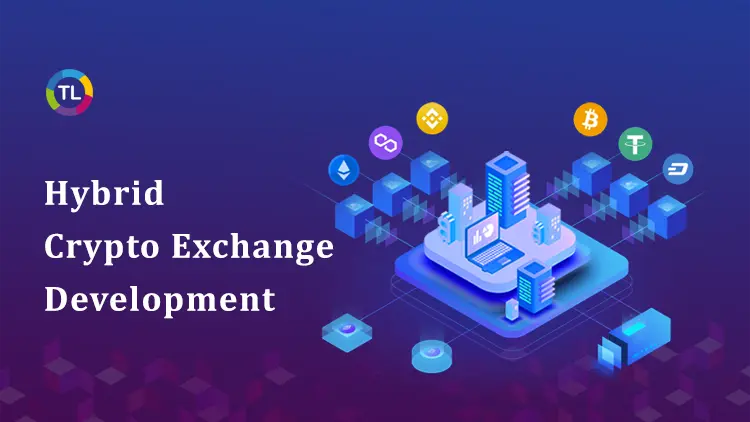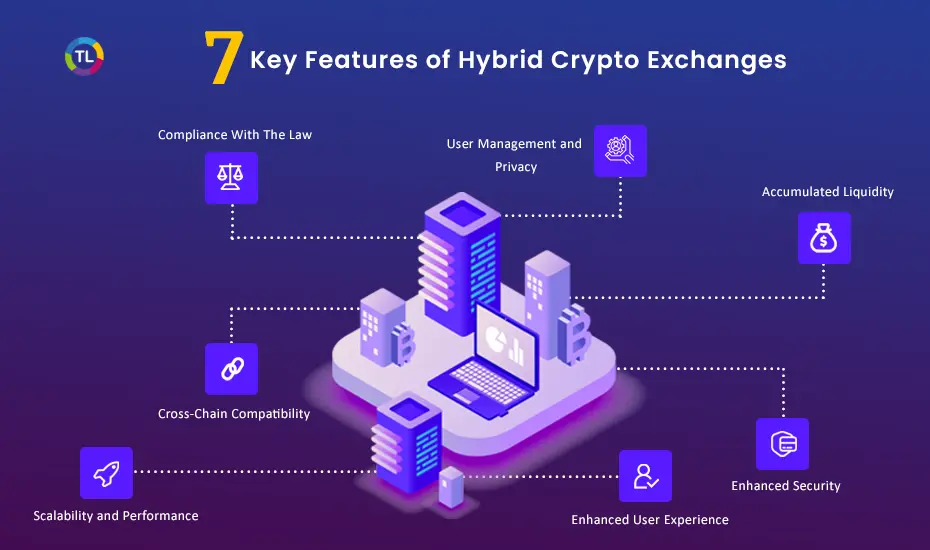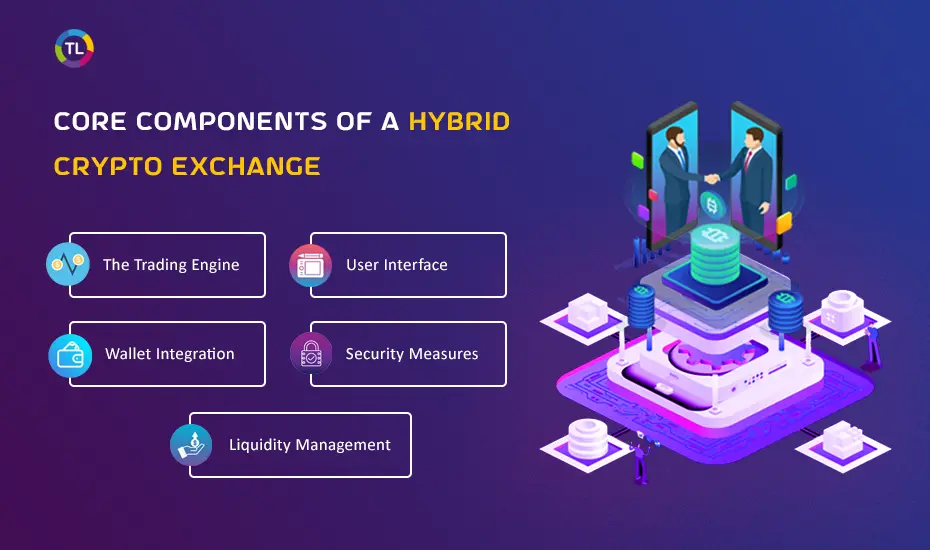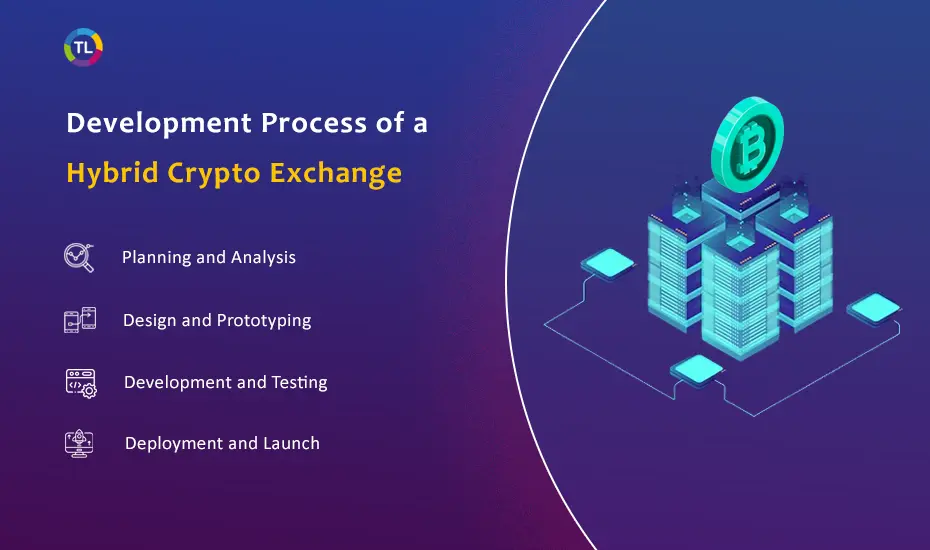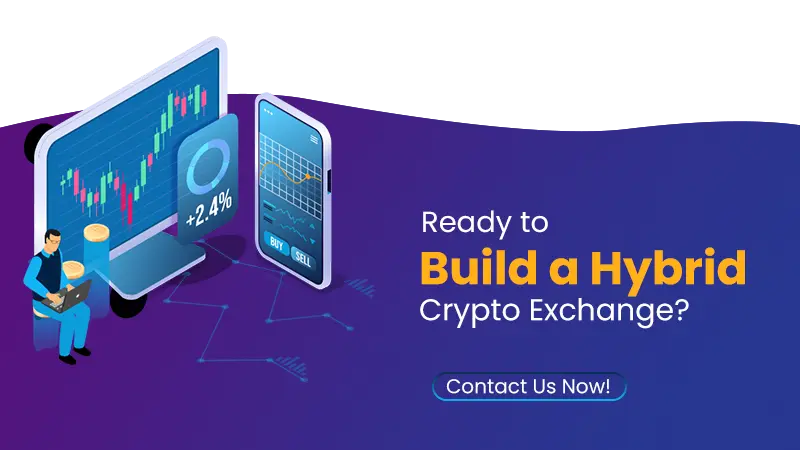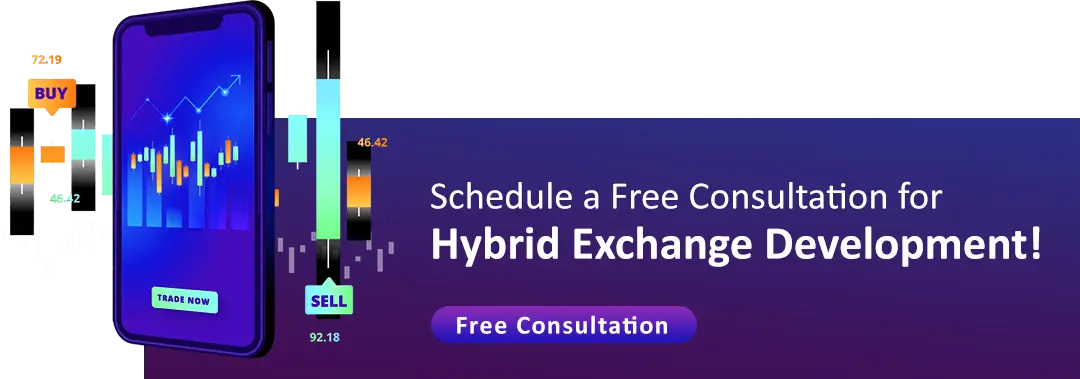Centralized and Decentralized crypto exchanges are two of the most popular crypto exchanges. While both of these crypto exchanges have their strengths, crypto users often struggle with their respective weaknesses. For instance, there are always security concerns with centralized crypto exchanges and seamless operation concerns with decentralized exchanges.
However, there’s one more type of crypto exchange that stands one step above the rest – Hybrid Crypto Exchanges.
Intrigued about hybrid crypto exchanges and their development? This guide will be your ally in comprehensive hybrid crypto exchange development.
From key features and market trends to the complete development process, this guide will talk about everything. So, without further ado, let’s get started.
Table of Contents
- 1 What is a Hybrid Cryptocurrency Exchange: A Quick Overview
- 2 Comparison of Hybrid Crypto Exchange with Centralized and Decentralized Exchanges
- 3 Advantages of Hybrid Crypto Exchanges
- 4 Key Features of Hybrid Crypto Exchanges
- 5 Hybrid Crypto Exchange Market Trends
- 6 Core Components of a Hybrid Crypto Exchange
- 7 Development Process of a Hybrid Crypto Exchange
- 8 Factors Affecting Hybrid Crypto Exchange Development Cost
- 9 Conclusion
What is a Hybrid Cryptocurrency Exchange: A Quick Overview
Cryptocurrency exchanges, a marketplace to trade cryptocurrencies with other currencies or any other digital assets, are generally of two types: Centralized and Decentralized.
Simply put, Hybrid cryptocurrency exchanges work as an incorporated version of both centralized exchanges (CEXs) and decentralized exchanges (DEXs).
DEXs and CEXs Generally Face Some Major Issues:
- Security concerns
- Liquidity challenges
- Use experience limitations
Hybrid crypto exchanges, on the other hand, deal significantly with these issues, becoming a more efficient crypto exchange platform.
But What Feature Makes Hybrid Crypto Exchanges Highly Efficient? This Combination:
- User-Controlled Wallets: Unlike CEXs, where the exchange wallet is under the control of a centralized unit, hybrid crypto exchanges give users complete authority over their private keys and wallets.
- Centralized Matching Engine: In order to perform efficient business operations and fast transactions, hybrid crypto exchanges use centralized matching engines.
- Smart Contract-Based Escrow Systems: This robust feature enables complete security of transactions until both the trading parties meet the trade conditions.
- Blockchain Integration: The integration of advanced blockchain technology offers increased security and complete transparency.
Comparison of Hybrid Crypto Exchange with Centralized and Decentralized Exchanges
In order to compare hybrid exchanges with centralized and decentralized exchanges, it is essential to understand what sets hybrid exchanges apart from the other two.
With Hybrid crypto exchanges, users get the best of both worlds. Integrate the strengths of both DEXs and CEXs and eliminate the major issues with them.
A centralized order book is essential to manage trades efficiently and quickly. Also, a decentralized framework ensures robust security and transparency. Hybrid crypto exchanges integrate both these functionalities and ensure strong security and complete user authority.
All in all, hybrid crypto exchanges with their dual nature, significantly improve the user experience and enhance trading operations.
Advantages of Hybrid Crypto Exchanges
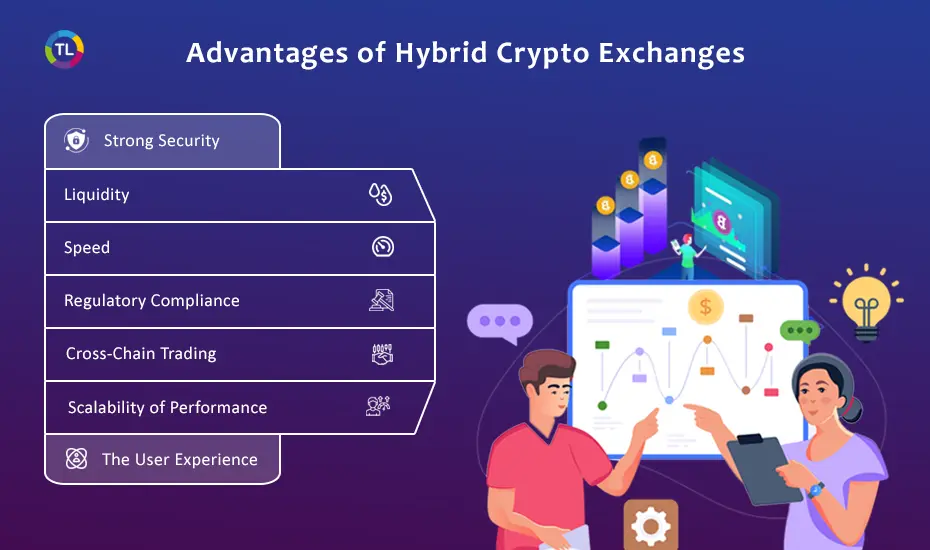
Strong Security
By offering direct custody of the users’ funds, hybrid crypto exchanges offer improved security and complete transparency. Hybrid crypto exchange users have control over their private keys and assets till the finalization of trade. This consequently leads to the reduced risk of hacks or thefts.
Liquidity
Hybrid crypto exchanges provide better liquidity than both DEXs and CEXs as it is the combination of centralized order books as well as decentralized liquidity pools. As a result, hybrid exchanges also lead to better prices for traders.
Speed
Due to the centralized order matching engine of hybrid crypto exchange, quick trade execution becomes a seamless process. With hybrid exchanges, users can easily make transactions directly through their wallets.
Regulatory Compliance
Hybrid crypto platforms also make it easy to comply with regulatory requirements. This may include implementing Know Your Customer (KYC), Anti-Money Laundering (AML) procedures, and following other regulatory guidelines without compromising user privacy.
User Usage
Users of hybrid exchanges generally have more control over their assets and privacy than centralized exchanges. They can retain ownership of their private key and choose when to transfer funds.
Cross-Chain Trading
Some hybrid exchanges support cross-chain trading, allowing users to trade assets on different blockchains. This could increase the variety of trading pairs available and attract more people interested in various cryptocurrency investments.
Scalability of Performance
Hybrid exchanges can potentially achieve much better scalability than decentralized exchanges, as they can leverage the capabilities of centralized components for order matching and processing by taking advantage of the extensive ecosystem of blockchain technology
The User Experience
Hybrid exchanges can provide a smoother user experience than decentralized exchanges, which sometimes suffer from problems such as high latency or complex user interfaces Hybrid exchanges aim to provide a simpler trading platform and do answer by integrating centralized components where necessary.
Overall, hybrid crypto exchanges seek to combine the best features of both centralized and decentralized models, with the goal of improving security currency, compliance, and user experience in a rapidly evolving cryptocurrency trading environment.
Key Features of Hybrid Crypto Exchanges
Here are some key hybrid crypto exchange features that make them desirable to many crypto traders:
Enhanced Security
One of the main concerns in the crypto space is security. Hybrid exchanges address this by allowing users to hold their funds until the time of the trade. Unlike centralized exchanges (CEXs), which require users to deposit money into an exchange wallet, hybrid exchanges enable direct peer-to-peer transactions without saving money. This reduces the risk of large-scale hacks and thefts because they do not invest in a specialized repository that is vulnerable to cyberattacks.
Accumulated Liquidity
Hybrid exchanges use pools of liquidity from centralized and decentralized sources. By connecting with various issuers and decentralized exchanges (DEXs), they ensure deep liquidity and competitive pricing for merchants. This consolidated currency enables faster order processing and reduces slippage, enhancing the overall shopping experience.
Compliance with the Law
Compliance with regulatory standards is crucial for a sustainable and legal crypto exchange. Hybrid exchanges incorporate measures to comply with regulatory requirements, such as Know Your Customer (KYC) programs, and implement anti-money laundering (AML) policies This program helps prevent illegal activities by ensuring compliance with laws in different countries while maintaining user privacy.
User Management and Privacy
Hybrid exchanges prioritize the freedom of users in order to maintain control over their private keys and digital assets. Unlike CEXs, which require users to transfer their funds, hybrid exchanges offer direct wallet-to-wallet transactions. This not only increases security but also protects the privacy of the user, as sensitive information remains under the control of the user.
Cross-Chain Compatibility
The most important advantage of a hybrid exchange is its interoperability. Trading is supported on blockchain networks, making it easy to exchange token assets regardless of their blockchain origin. These chain networks expand business opportunities and promote wider acceptance of cryptocurrencies, attracting traders interested in diversifying their portfolios in blockchain ecosystems
Scalability and Performance
The hybrid exchange combines the efficiency of a centralized order-matching engine with the decentralized nature of blockchain technology. This hybrid design allows for improved scalability and efficiency compared to fully decentralized exchanges (DEXs), which often face speed and transaction throughput challenges. Leveraging centralized components where needed, hybrid exchanges can handle high transaction volume and provide a seamless user experience.
Enhanced User Experience
User experience is paramount to gaining acceptance and retention on any marketing platform. The hybrid exchange aims to provide a user-friendly interface, responsive customer support, and flexible trading tools. By combining the best features of centralized and decentralized models, they offer an appealing balanced approach for novice and experienced traders alike.
Read More: OTC Exchange Platform Development – Benefits and Its Key Uses
Hybrid Crypto Exchange Market Trends
The growth of the hybrid crypto exchange market is increasing rapidly as it combines the advantages of centralized and decentralized exchanges.
Looking ahead, hybrid exchanges are expected to integrate more DeFi services, improve interoperability between blockchain networks, expand offerings to include tokenized assets, and most importantly, AI integration.
Future forecasts suggest that as technology evolves with stronger regulatory frameworks, hybrids will become an important part of the crypto trading ecosystem, versatile for many types of investors and offering robust compatibility.
Core Components of a Hybrid Crypto Exchange
A hybrid crypto exchange combines the strengths of centralized and decentralized architectures, providing traders with improved security, liquidity, and processing capabilities.
Let’s explore the essential features that define what a hybrid exchange platform is:
The Trading Engine: Process Orders Efficiently
At the heart of any hybrid crypto exchange lies its trading engine that processes and matches buy and sell orders. This phase ensures the seamless execution of trades by:
- Order Matching: Buy and sell orders are matched based on predefined algorithms to ensure fair and efficient trading.
- Scalability: Handling high workloads without compromising speed or performance.
- Risk Management: Implementation of measures to mitigate risks such as market fluctuations, and order book discrepancies.
A trading engine on a hybrid exchange improves the speed and reliability of transactions, which is critical to maintaining trader confidence and market capitalization.
User Interface: Design and Customization
The user interface (UI) of a hybrid exchange plays an important role in shaping the crypto trading experience:
- User-Friendly Design: It offers an intuitive interface that simplifies workflows and enhances users of all experience levels.
- Customization Options: Allows users to customize their dashboards, charting tools, and trading preferences according to their individual needs and crypto trading strategy.
- Mobile Compatibility: Make sure devices like desktops, tablets, and smartphones are all compatible to work on the go.
A well-designed UI not only satisfies users but also helps to increase productivity and platform engagement.
Wallet Integration: Secure Storage Solutions
Wallet integration is vital for users to securely store and manage their digital assets:
- Types of Wallets: Supporting different wallet types including hot wallets (connected to the internet for quick access), cold wallets (offline storage for enhanced security), and multi-signature wallets (requiring multiple keys to authorize transactions).
- Secure Storage: Implementing robust security protocols to safeguard user funds against unauthorized access and potential cyber threats.
By integrating secure wallet solutions, hybrid exchanges empower users with full control over their assets while prioritizing the safety of stored funds.
Security Measures: Protecting User Assets
Strong security protocols are something that distinguishes hybrid crypto exchanges from the rest.
- Two-Factor Authentication (2FA): Additional security by asking users to verify their identity through multiple methods of authentication.
- Encryption: Advanced encryption techniques are used to protect the transmission and storage of sensitive data and prevent unauthorized access.
- KYC/AML Compliance: Apply Know Your Customer (KYC) and Anti-Money Laundering (AML) regulations to verify user authentication and monitor suspicious transactions, ensuring compliance on the basis of standards.
Liquidity Management: Enhancing Market Efficiency
Cash flow management is essential to maintaining a healthy operating environment:
- Liquidity Pool: a pool of funds pooled from various sources, including internal reserves and external funding, to ensure adequate liquidity for trading activities.
- Connections with Exchanges: To provide a broader diversity of trading pairs by forming partnerships and alliances with other exchange bodies to generate additional financing.
- Effective currencies dampen falls and raise prices, attracting more traders and contributing to a vibrant trading system.
Development Process of a Hybrid Crypto Exchange
Building advanced hybrid crypto exchanges requires a structured development process to ensure functionality, security, and user-friendliness.
Planning and Analysis
- Market Analysis: The journey begins with a comprehensive market analysis to understand the current trends in crypto trading, competitor landscape, and emerging technologies. This stage helps to identify gaps and opportunities for differentiation.
- Identify Target Audiences and User Needs: Defining the target audience—be it retailers, or institutional investors—guides priorities and user experience decisions.
Design and Prototyping
- User Experience (UX) and User Interface (UI) Design: UX/UI design plays a key role in hybrid exchanges where seamless user experience and navigation are important. Designers focus on creating a seamless business experience while maintaining visual interest and functionality
- Creating Wireframes and Prototypes: Translating design ideas into real wireframes and prototypes helps visualize the exchange interface and interactions. It allows stakeholders and potential users to quickly access information and prepare the system before development begins.
Development and Testing
- Backend and Frontend Development: The development phase is to build the backend infrastructure for order matching, liquidity management, wallet integration, and API usage. At the same time, frontend development ensures that the user interface is responsive, scalable and integrates with backend systems it is not difficult.
- Security, Performance, and Functionality Testing: Rigorous testing is conducted to identify and address security vulnerabilities, ensure proper functioning under heavy load, and validate the user experience across devices and browsers. Thus, this process is very important to maintain trust and confidence.
Deployment and Launch
- Preparing for a Successful Launch: As the end of the hybrid exchange development approaches, preparations for the brand intensify. This includes completing regulatory and regulatory compliance, developing customer service strategies, and coordinating with lenders and payment processors.
- Marketing and User Strategies: A well-designed sales strategy is essential to attract first-time users and generate business volume. The use of social media, influencer sharing and targeted advertising helps create buzz, driving traffic to the platform.
Factors Affecting Hybrid Crypto Exchange Development Cost
There are a number of factors that affect hybrid crypto exchange development costs. Understanding these factors is important for budgeting and ensuring smooth execution. Here are the main factors affecting the development cost of a crypto exchange:
Change Quality and Complexity
Hybrid exchanges that combine features of centralized and decentralized platforms require robust development to ensure integration and seamless operations. Complex features such as order matching, liquidity management, and user authentication affect development time and cost.
Safety Requirements
Implementing complex security measures such as multi-factor authentication (MFA), encryption protocols, cold storage for funds, and regular security audits increases development costs. Compliance with regulatory standards and obtaining the necessary licenses further help.
User Interface (UI) and User Experience (UX) Design
Investments in convenient navigation, improved device design, and user-friendly networks increase user engagement but also increase development costs. Design iterations, prototyping, and usability testing are important steps that require additional resources.
Backend Development and Infrastructure
The backend infrastructure of the crypto exchange includes order processing, database management, API integration with external services (such as payment gateways and KYC providers), and the use of blockchain technology. All these consequently, add to the cost of development.
Compliance with the Law
Navigating regulatory requirements and obtaining licenses to operate legally in different jurisdictions is an important part of crypto exchange development. Compliance costs vary widely depending on the jurisdiction, regulatory framework and legal advice sought. Failure to comply could also result in fines, legal challenges, or closure of the business.
Liquidity and Market Integration
Ensuring high liquidity on the exchange requires seamless integration with lenders and cooperation with market participants. The cost of establishing these networks and implementing cash management solutions affects the entire development budget.
Project Management and Team Formation
The size and number of Hybrid crypto exchange development teams, project management style (Agile, Waterfall, etc.), and outsourcing decisions also affect costs. Hiring a Hybrid crypto exchange development company, UI/UX designers, security experts and legal advisors contributes to the growth economy. Effective project management ensures timely delivery and minimizes cost overruns.
Read More: Decentralized Cryptocurrency Exchange Development : A Complete Guide
Conclusion
There you have it, your complete guide to hybrid crypto exchange development. This guide will certainly help you with all your doubts related to developing a P2P crypto exchange.
The development process through this guide might seem like a seamless process, however, without a professional Cryptocurrency Exchange Development Company, it is impossible to create a successful hybrid exchange that stands out from the rest.
This is where Technoloader comes in!
Connect with Technoloader today and get your professional hybrid cryptocurrency exchange developed with a team of experienced developers by your side. You’ll be all on your way to a successful hybrid cryptocurrency exchange development.
Frequently Asked Questions
Q. What Security Measures does Technoloader Implement?
Ans. In order to protect user data and assets, Technoloader ensures robust security implementation with important measures such as –
- Multi-Factor Authentications (MFA)
- Cold Storage
- End-to-End Encryption
- Smart Contract Audits
- DDoS Protection
- KYC and AML Compliance
- Regular Security Audits
- Secure APIs
- Data Encryption
- Role-Based Access Control (RBAC)
By implementing these security measures, Technoloader aims to provide a secure and reliable trading environment for their users.
Q. How does Technoloader Ensure Compliance with Regulations?
Ans. Technoloader comply with regulations through a combination of strategic measures and technologies:
- KYC (Know Your Customer) Protocols
- AML (Anti-Money Laundering)
- GDPR Compliance
- Licensing and Registration
- Regular Audits
- Data Security Measures
- Legal Counsel and Advisory
- Transparent Reporting
- Compliance Officer
- Education and Training
By integrating these measures, Technoloader operates the complex regulatory process and builds trust with users and regulatory bodies alike.
Q. What Support and Maintenance Services does Technoloader Offer?
Ans. To ensure the smooth operation and continuous improvement of the hybrid crypto exchange platform, Technoloader offers a number of hybrid cryptocurrency exchange solutions such as:
- 24/7 Technical Support
- Regular Updates and Upgrades
- Security Monitoring and Incident Response
- Performance Optimization
- Bug Fixes and Troubleshooting
- Compliance Updates
- Backup and Recovery
- User Training and Documentation
- Scalability Support
- Custom Development Services
- Customer Feedback Integration
- Periodic Audits and Reporting

